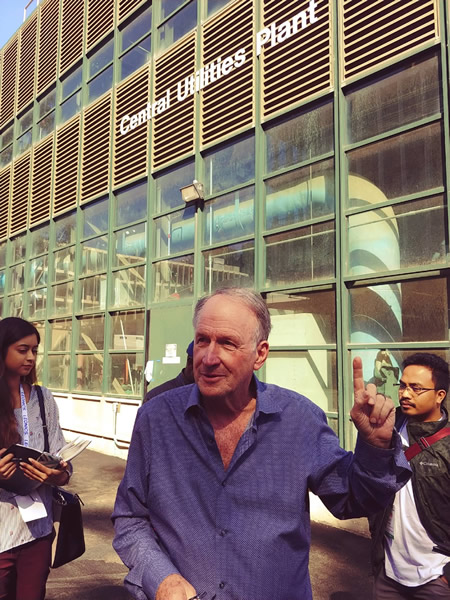 One of the highlights of the HOMER International Microgrid Conference, held October 8-10 in San Diego was a tour of the microgrid at the University of California San Diego (UCSD) campus. The tour was led by Byron Washom, the university’s Director of Strategic Energy Initiatives and the force behind many of UCSD’s award-winning energy innovations. As a current demonstration of clean power solutions that most of us can only imagine, the microgrid was by all accounts a great inspiration for participants at the HOMER conference. Dozens of them had made long trips from overseas to attend, and had never seen such a collection of cutting-edge projects.
One of the highlights of the HOMER International Microgrid Conference, held October 8-10 in San Diego was a tour of the microgrid at the University of California San Diego (UCSD) campus. The tour was led by Byron Washom, the university’s Director of Strategic Energy Initiatives and the force behind many of UCSD’s award-winning energy innovations. As a current demonstration of clean power solutions that most of us can only imagine, the microgrid was by all accounts a great inspiration for participants at the HOMER conference. Dozens of them had made long trips from overseas to attend, and had never seen such a collection of cutting-edge projects.
Noting the merits of various technologies that power the world’s most advanced microgrid, Washom said that because of ample research funding, various regulatory advantages, and the availability of top engineering talent, UCSD is an ideal laboratory for energy innovation, lending itself to the rapid deployment of promising new energy concepts that he described as “pearls on a necklace.” As a further incentive to energy leadership, California has announced a succession of challenging carbon reduction goals, obligating state institutions to integrate more clean energy into their planning. For example, the Carbon Neutrality Initiative, announced in 2013, commits University of California campuses to net zero greenhouse gas emissions from buildings and vehicle fleets by 2025.
Energy Infrastructure Built in the 1960s Paved the Way for Current Innovation
The relatively new UC San Diego campus, built from scratch in the 1960s, provided some important advantages in the creation of modern energy infrastructure. One crucial feature is a campus district heating and cooling system constructed on open land that had once been a military base. That system allows for the efficient distribution of chilled water around the campus, cooling buildings in the hot desert climate and avoiding fossil-generated electricity for air conditioning.
Built in stages over the ensuing decades, the UCSD microgrid now powers a campus that covers 1200 acres and serves a community of about 45,000 faculty and students living and working in 450 buildings.
UCSD generates about 85% of its own energy, at about half the price that utility power would cost, adding up to millions of dollars in savings each year. That level of contribution to its own power supply is even more amazing considering that the campus has an energy density three times greater than average commercial properties because of its supercomputing center, research laboratories and hospital. Remaining power is supplied by the local utility, San Diego Gas & Electric (SDG&E). The total peak demand is 47 MW, expected to grow to 80 MW in the future. The mission-critical requirements of its health facilities, laboratories and computing centers mean that the UCSD power system requires 60 MW of fail-safe emergency backup power supplied by diesel generators, only permitted to operate in true emergencies.
Natural Gas Cogeneration Plant
The heart of the UCSD energy system is an award-winning cogeneration plant – the “Central Utilities Plant” – featuring two high-efficiency 13 MW natural gas turbines. Waste heat from the turbines is used in absorption chillers to create cool water stored in a nearby 3.8 million gallon tank that is eight stories tall and four stories wide. Sent out at 34º and returned at 54,º the water circulates throughout the campus, efficiently cooling the buildings. In fact, 95% of the cooling on campus, which has about 10 million gallons of chilled thermal storage in total, comes from waste heat recovery.
It’s important to note that according to the International Energy Agency, increasing demand for air conditioning is the most important driver of the growth in global electricity demand. That is fueled in turn by coal-fired power plants that are the key contributor of C02 to the atmosphere. The UCSD campus microgrid illustrates an economically feasible alternative to electrical air conditioning created from combustion of fossil fuels.
Despite the high efficiency and reliable performance of its cogeneration plant, UCSD will soon be faced with the requirement to operate free of fossil fuels in order to meet the 2025 net zero greenhouse gas emissions requirement for universities. UCSD is in the midst of planning how to reach that goal, part of which will be accomplished by replacing natural gas with biogas from landfills or agriculture.
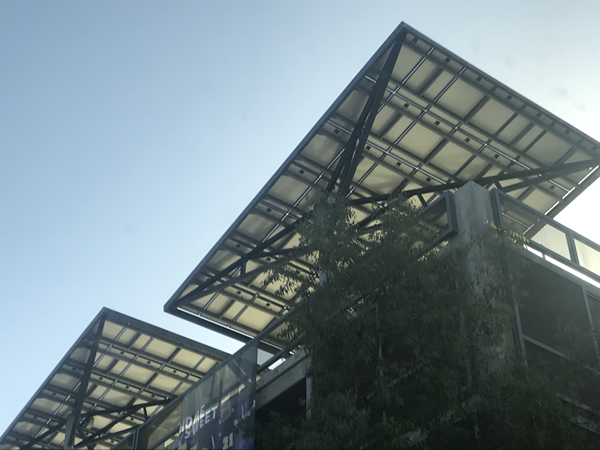 Solar Resources
Solar Resources
The UCSD microgrid has a 3MW network of solar resources connected to it, including a carport and various rooftop and ground mounted arrays. Several of these are integrated with advanced energy systems including battery storage. The university has also installed a 300-kilowatt solar water-heating system at its North Campus Housing location, one of the largest solar-thermal projects at a North American university. Washom explained that students figure out quickly how to time their daily showers to take advantage of the solar-heated water.
 Energy Efficient Buildings: Low Tech, High Importance
Energy Efficient Buildings: Low Tech, High Importance
UCSD has several buildings that have achieved a LEED (Leadership in Energy and Environmental Design) Platinum energy efficiency rating, the highest standard possible. New buildings at UCSD are prohibited from using fossil fuels for heating or cooling. The LEED Platinum buildings have a variety of energy conservation features including roofs covered with soil and planted with trees, grasses and community gardens. Aside from creating enjoyable spaces to gather, “green roofs” provide important insulation from the desert heat. Declaring the buildings one of his favorite stops on the microgrid tour, Washom says that energy efficiency is a crucial prerequisite to a successful hybrid renewable energy system.
Some buildings have solar thermal systems installed as well as innovative cooling mechanisms. The dog leg in the building (visible just below the solar thermal system on the top left of the roof) creates a wind imbalance that helps cool the building. In addition to the rooftop solar water heating system, there is passive solar design; also special wind catchers on the windows snag sea breezes and use them – instead of air conditioning – to cool warm rooms. Other LEED Platinum buildings on campus have latticed balcony dividers that provide shading, not to mention unique aesthetic effects.
Finally, energy-efficient ventilation systems, LED lighting, high-efficiency appliances and ongoing monitoring and tuning of building energy performance are standard fare at UCSD. So far the university has spent over $100 million on efficiency upgrades, saving over $12 million in annual energy costs. UCSD plans to spend another $50 million in efficiency improvements over the next five years.
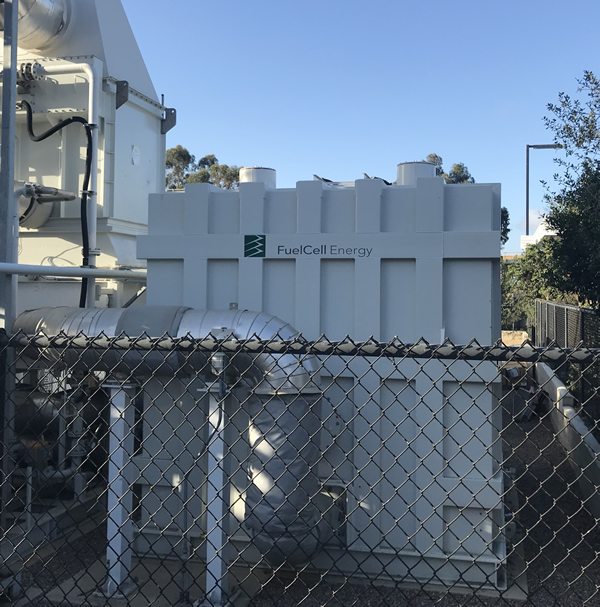 Fuel Cell
Fuel Cell
One of the most intriguing features of the UCSD microgrid is a 2.8 MW fuel cell, the largest on any U.S. college campus. The fuel cell uses methane from a regional wastewater treatment plant which is then broken down in an electrochemical process to output electricity and waste heat. The waste heat is used to power a 300-ton absorption chiller that produces cold water which is then piped to a multi-million gallon thermal storage tank nearby. The fuel cell provides about 7% of UCSD’s total electrical needs, the equivalent of powering 2,800 homes.
Whereas waste methane is often flared into the atmosphere where it traps nearly thirty times more of the Earth’s heat than C02, productive uses of methane such as fuel cells can dispose of this harmful gas in safer ways, with the added benefit of energy production.
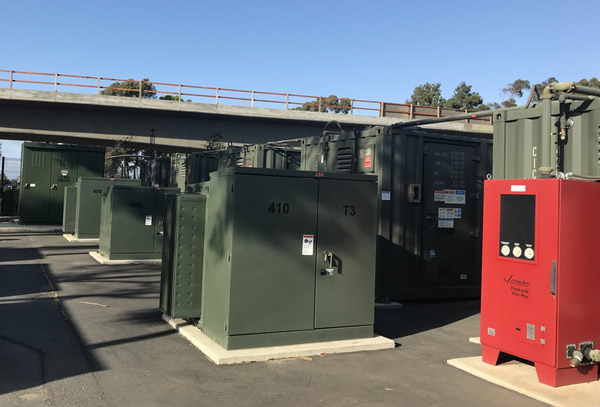 Advanced Energy Storage
Advanced Energy Storage
Located in UCSD’s Energy Research Park not far from the giant fuel cell are several components of the university’s 2.5 megawatt advanced energy storage system, capable of delivering a megawatt of power for up to five hours. As the university adds more renewable resources to the microgrid, the storage resources are likely to grow.
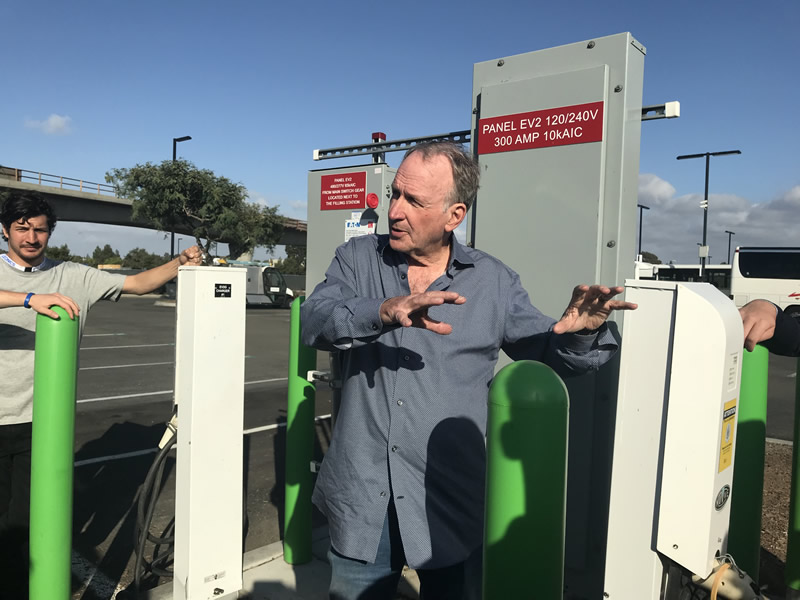 EV Charging
EV Charging
The final frontier in UCSD’s energy innovation program harnesses the rapid growth of the electric car industry to test and verify EV charging stations, batteries, software and a host of other technologies that will enable our new electric transportation industry. That’s a good thing too, because without radical transformation of its current fossil-based transportation sector, California doesn’t stand a chance of meeting its ambitious carbon reduction goals. So far there are 125 commercial charging stations on the UCSD campus serving 600 unique commuters. The catch, says Washom, is a whopping growth rate of 9% per month, which will require the university to commit to continuous installation of new charging stations.
The two-acre UCSD Energy Research Park features a wide variety of advanced commercial EV charging experiments as well as facilities that are available for public use. This is where major auto manufacturers from the U.S. and Europe are testing vehicle-to-grid charging, “smart” charging stations that monitor car battery state-of-charge and react accordingly, and other EV charging improvements. Can car batteries withstand the ongoing wear and tear of charging and discharging back to the grid? How will fast-charging stations affect electricity demand and can they be powered by renewable resources?
After several hours of touring UCSD generation resources, it was clear that the university has achieved a remarkable degree of energy independence and carbon reduction through a combination of resourcefulness, energy efficiency and the deployment of powerful new renewable technologies. But how does this exemplary microgrid fit into the larger context of our electric power system?
Living in Perfect Harmony: How the UCSD Microgrid Relates to Its Local Utility
It seems that – beyond serving as a demonstration facility for continuous energy innovation – UCSD microgrid managers are learning important lessons about how a large microgrid operates in synergy with its utility partners. Despite its ability to isolate itself from the grid, UCSD collaborates closely with the organizations around it:
First, USCD is the biggest demand response customer for San Diego Gas & Electric, helping the utility meet peak demands by reducing campus loads upon request. Following a carefully planned sequence of steps, UCSD can reduce power consumption – and be paid by the utility – when it cuts back on its chiller operations, puts designated buildings into an “unoccupied” energy state, and finally, triages critical vs. non-critical electrical loads.
Secondly, the UCSD microgrid generates so much electricity from solar PV at midday that it creates a negative price point of -2¢ per kWh; it pays Arizona to take the electricity. Meanwhile, UCSD also pays San Diego Gas & Electric to “wheel” (or trade) power that the university buys from independent power producers elsewhere on the grid.
Finally, although it wasn’t the original intention behind the microgrid design, UCSD can also provide vital backup to the main electric grid in emergencies. Just such a situation arose in 2007 when a chain of wildfires erupted across San Diego county. Driven by Santa Ana winds, the fires burned for almost a month, incinerating more than 350,000 acres, prompting the evacuation of half a million people, causing loss of life and destroying nearly 2,000 homes.
In the middle of the catastrophe, UCSD got an urgent call from San Diego Gas & Electric: The utility had been forced to shut down a transmission line because of the fires, and was facing a critical power shortage. Could the university help? Although the UCSD can “island” (or cut itself off) itself from the main grid in 250 milliseconds, it can also feed power back to the utility, and in 2007, it did just that. Normally a 3 MW importer of electricity from SDG&E, UCSD was able to export 10 MW to the utility within 7 minutes, averting a power shortage and crisis on the grid.
Our heartfelt thanks to Byron Washom and UCSD for such an in-depth look at a bright and inspiring energy future.

Dear Ms. Francklyn, et. al. Thank you for sharing this remarkable story. American-made, profitable innovation, clean energy deployment, and above all, inspiration for others.
So often I read of such things in Sweden and Germany. So proud to have all this taking root at my Alma mater. I have one big question for you and Mr. Washom. As a strong climate solutions advocate, I am keen to learn how you did it and how can this be scaled nation-wide?
According to the article, “because of ample research funding, various regulatory advantages, and the availability of top engineering talent, UCSD is an ideal laboratory for energy innovation, lending itself to the rapid deployment of promising new energy concepts that he described as ‘pearls on a necklace.’
As a further incentive to energy leadership, California has announced a succession of challenging carbon reduction goals, obligating state institutions to integrate more clean energy into their planning. For example, the Carbon Neutrality Initiative, announced in 2013, commits University of California campuses to net zero greenhouse gas emissions from buildings and vehicle fleets by 2025.”
Can I summarize by saying it was mainly due to California’s emissions goals and regulatory approach–regulations, cap and trade, clean energy incentives and subsidies, etc.–that provided the motivation?
Anything else? And if so, how do you think we can spread all these technologies–which do not strike me as breakthroughs in and of themselves, but in their ground-up system design, integration, and application. And then how can we get every university, every city and municipality in the US to follow your footsteps?
As you know, we do not have decades but years to do this.
Allow me to suggest my best idea and answer my own question. Given that a national policy encompassing California’s regulatory approach is a long shot, what do you think of a carbon price with a dividend going back to the wider economy? Specifically, what do you think of the bipartisan Energy Innovation and Carbon Dividend Act (H.R. 763)?
Thank you for this monumentally important accomplishment and may your example breed many emulations–very coon.
Gratefully, Dadla Ponizil, volunteer, CitizensClimateLobby.org
Dear Dadia,
Thank you for your thoughtful comments. You are absolutely right that California’s leadership in clean energy policy is certainly a very important factor in the success of the UCSD microgrid. There is also the fact that as a university, UCSD has some advantages over other types of organizations, and never underestimate the passion and expertise of people like Byron Washom who has led the university’s “deep decarbonization” initiative for years. https://deepdecarbon.ucsd.edu/people/washom.html How best to propagate these ideas? We do our best by publishing stories about them, and hope that people share them. In seeking to decarbonize our energy system we are all part of a paradigm shift that reaches into every aspect of our economy and technical infrastructure. It is a big challenge! Like you, I am encouraged by the bi-partisan cooperation we are seeing with the Carbon Dividend Act. Let’s hope that collaboration becomes catching in Congress!
Sincerely,
Lili Francklyn